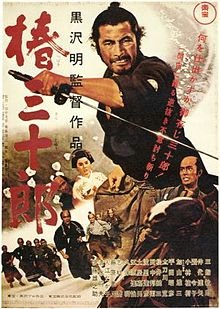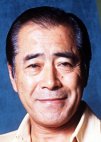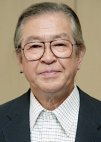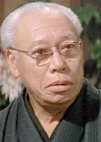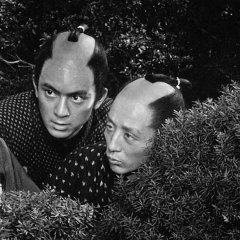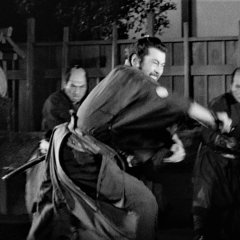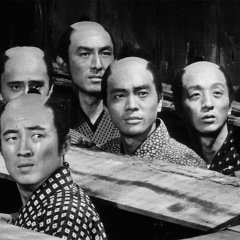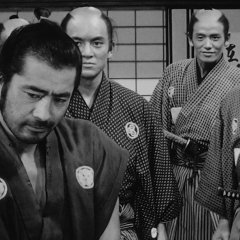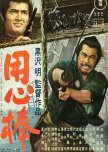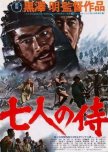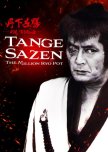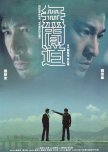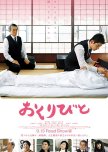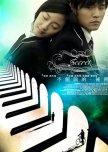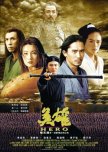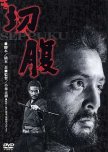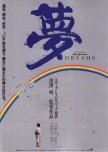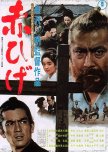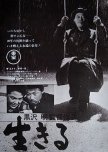 Ask MDL: Thrillers
Ask MDL: Thrillers - Română
- 中文(台灣)
- Türkçe
- English
- Titlu Nativ: 椿三十郎
- De asemenea cunoscut ca și: Tsubaki Sanjuro
- Scenarist și Regizor: Kurosawa Akira
- Scenarist: Oguni Hideo, Kikushima Ryuzo
- Genuri: Acțiune, Thriller
Unde Urmăriți Sanjuro
Subscription (sub)
Cast și credite
- Mifune Toshiro Rol Principal
- Nakadai TatsuyaMuroto HanbeiRolul de Sprijin
- Kobayashi Keiju[Spy]Rolul de Sprijin
- Kayama YuzoIzaka IoriRolul de Sprijin
- Dan ReikoChidori [Mutsuta's daughter]Rolul de Sprijin
- Shimura TakashiKurofujiRolul de Sprijin
Recenzie

Aren't you tired of being stupid yet?
Director Kurosawa and Mifune Toshiro brought back the iconic samurai character, Sanjuro, for this sequel to Yojimbo. Once again turning the genre on its ear, Kurosawa questioned the violence and death of the samurai code and the genre and asked his characters to distinguish between reality and appearances, duty and wisdom.Nine young samurai are in a quandary after the Chamberlain has rejected their report on corruption, thinking he must be the problem. The Chamberlain had warned them that appearances can be deceiving. People are not what they seem. And with that we are giving the central theme to this film. And Mifune's introduction as he walks into the temple room stretching from an undetected nap in the back. Scruffy, scratching, with a beard and unshaved head, the young stoic samurai were not impressed with the man in front of them. But this Sanjuro, more controlled in demeanor and wiser than in Yojimbo immediately sizes up the problem. The Chamberlain is unattractive, and the Superintendent looks the part, thus causing people to distrust the one and trust the other simply by appearances. He immediately grasps that the young samurai are about to be attacked and saves them.
This casual ronin has grown since his last adventure. Where he conned the locals for money in Yojimbo, here he takes only what he needs. The 9 act as one and think as one, trailing after Sanjuro like a centipede. Again and again, he has to calm their foolish headstrong ways, questioning their rules and conformity which is leading them into a dangerous pit. This Sanjuro is a mentor and altruistic, constantly putting himself in danger to keep the young ones out of it.
Whereas Yojimbo was a dirty, dilapidated town, this film is all clean with neat lines. The characters are rigid and vertical, while Sanjuro is loose and often found reclining. Not that Mifune forgot how to swagger, he still had that virile swagger set to music on several occasions. In most of the shots with The 9 he is set apart somehow, a loner who likes to be alone and doesn't play by the samurai rules.
When they rescue the Chamberlain's wife we hear the second theme of this film. The wife tells Sanjuro, "You are like a sword without a sheath. You cut well, but the best sword is kept in its sheath." While this film does have several fights and deaths, the message that violence is not always the answer comes through loud and clear. The wife's mercy for a guard they capture became one of my favorite comic parts of the film. Stashed in a closet he would come out and give words of wisdom as he discovered the Superintendent was the corrupt person and not the Chamberlain. The captured guard was a good man, saved from death and wrong living by not being cut down for honor's sake.
This was a gently comic film as Sanjuro worked to keep the young samurai alive and rescue their leader. Just as he did in Yojimbo, Nakadai Tatsuya played Mifune's nemesis. Nakadai's Muroto, like Sanjuro, was a warrior from the old school. The two recognized the tiger in each other, both unsheathed swords.
So great was the message of sheathing swords that the main climax came with cut camellias instead of pools of blood. Only at the end when the inevitable duel between Sanjuro and Muroto could no longer be avoided, did the blood fall. Kurosawa gave us 35 seconds of silence as the two samurai sized each other up. His use of silence in film is one of the things I enjoy. It builds tension and slows the action so that we have time to process what is about to happen.
My love for Kurosawa's shots is great. His frame-within-a-frame shots were stunning in this film. A night scene in gauzy smoky light wafting about Mifune and Nakadai was striking. His use of wide-angle shots, boom shots, low shots all brought this story to life in the most vivid way.
Mifune had this scratching, confident, at times vulgar, character down. With his cat-like speed he perfectly played the samurai who hated to draw his sword, but when called upon was proficient. Going against the grain, no longer a ronin because he couldn't find a master, now one by choice as he wandered alone. A rugged individual, he could not be an obedient servant confined to the rules of bushido. Though only a year had passed in the real world, Mifune's Sanjuro had matured immeasurably in film time.
There were some repetitive moments and places where the plot and action slowed uncomfortably for me, but overall, I found this film entertaining. Mifune's Sanjuro was fun to catch up with again, a samurai like no other, one that broke the mold. It was with sadness that I watched that scruffy, wiser, warrior walk off into the sunset.
10/17/22
Considerați utilă această recenzie?

Excellent, superb, Kurosawa's amazing masterpiece.
The final sequence of the movie just caught me up. While Akira Kurosawa and the crew put the budget in the last blood, there is so much tension when talking about this scene. The atmosphere was silent but Sanjuro had to part with the people he had helped. However, once again, he just doesn’t want to ruin everything. Be he must leave everything. If not, the sharp sword would only keep everyone out of control. And the best part of the sequence is the tense. It’s just so quiet but there is no exaggerated cut or close up; the Sergio Leone style. The image was just there, didn’t move and the audience just waited for who would take out their swords as soon as possible. It’s a battle between dead or alive.Kurosawa and Mifune, a true combination, worked together again in a sequel directed by the original director. While not excessive to say this is a masterpiece as well as “Yojimbo”, “Sanjuro” is a fantastic underrated motion picture by the director. The story star with a group of young samurai is in a political game. The Superintendent of a clan is plotting to take the clan by implicating the Chamberlain to do corruption. The plan included killing the staff of the Chamberlain and other defilements. Enter the famous ronin from behind to help them. In this case, the ronin tried to question who was really right and himself, after all, that had happened in “Yojimbo”.
The story is quite confusing, different from “Yojimbo” where the main characters move from one party to another. The story is a bit of complicated but still interesting and unpredictable because of various twists in it. Sanjuro is a cunning yet genius, not too hasty, but also lazy. He puts a lot in his plan and motion in order to take this clan collapses little by little. At first, Sanjuro always mocked them because of their ignorance and impatience made Sanjuro’s plans fall apart. But, as soon as Sanjuro went through a lot of things with them including meeting the Chamberlain’s wife, he tried to question. Whether he had become a good person or was still not enough intake to his redemption in “Yojimbo”.
The story takes a serious drama with its complexity and the main character actions in learning one to another clan. While these serious things, the movie has a lot of comical moments and comedy as well. It’s a Kurosawa universe, sad, action, and drama in one story. Kurosawa is trying to make you believe this is still a film about Sanjuro. But, the comedy is what makes me feel comfortable. He didn’t try to ruin these serious moments but kept its tone as much as possible which is not too serious too. Kurosawa, when it comes to comedy, is hard to believe when you laugh with a serious tragedy but you still deal with it.
This is a not-rated movie. This movie is action and violence. The final sequence of the movie literally goes to this even though it’s still funny why the rating is like that. Although it’s presented in black and white, the sequence is so effective. The shocking and the most amazing yet beautiful final moment in magic carried out by the director. The movie, besides the final sequence, also has great choreography. One of them was when Sanjuro had to fight 10 people while protecting the 4 clans he helped. All of the moments focus mostly on the tactics and intelligence of this and another clan. They don’t just always face and fight.
“Sanjuro” is more like a Kurosawa style movie than the spaghetti westerns of “Yojimbo” in a visual presentation but more polished. “Yojimbo” has a more mixed bag and “Sanjuro” is more to a solo movie, more bright but still gorgeous. There is nothing wrong with both movies because I prefer “Yojimbo” which still shows a lot of visuals rather than this film. Both movies work very well together in the first and final Mifune’s Sanjuro trip. It gives a little more complex and in-depth in its character.
Considerați utilă această recenzie?

